Experimental Investigation of Characteristics of Sand Production in Wellbore during Hydrate Exploitation by the Depressurization Method
Abstract
1. Introduction
2. Experimental Apparatus and Process
2.1. Experimental Apparatus
2.2. Materials
2.3. Experimental Procedure
3. Results
3.1. Pressure Characteristic and Production Periods
3.2. Temperature Related Characteristics
3.3. Sand Production in Hydrate Production Tests
3.3.1. Sand Production in Hydrate Production Periods
3.3.2. Size of the Produced Sand and Sand Rates in the Production Water
4. Discussion
4.1. Driving Force and Mechanism of Sand Production during Hydrate Exploitation
4.2. Subsidence of Hydrate-Bearing Sediments with Sand Production
5. Conclusions
- (1)
- Three hydrate production periods were observed; water production by depressurization, gas production with water drops, and low gas production.
- (2)
- The sand production phenomena were different during different hydrate production period. Production of whole fine sand and sand grains was noted in the first and second periods, respectively, and no significant amount of sand was produced in the third period.
- (3)
- Sputtering unique to hydrate decomposition may provide the driving force for sand migration. The flowing gas bubbles and water from hydrate decomposition enhanced the sand carrying capacity and reduced the strength of hydrate-sand cementation and skeleton solids.
- (4)
- From the experiments, the subsidence of hydrate-bearing-sediments could be over 10% with sand production. Thus, higher sand production led to the higher subsidence. The loss of crustal pressure may increase the subsidence. The dynamic subsidence of the hydrate layers and sand production alter the seepage characteristics, thermal properties and material balance of the hydrate layers. The temperature related characteristics are affected by hydrate production periods. The final subsidence of the hydrate-bearing sediment when crustal stress was not maintained was very high at over 10 mm (10%). When there was no wellbore collapse or sudden collapse of the sediment, the subsidence was no more than 5 mm (5%).
Author Contributions
Funding
Conflicts of Interest
References
- Sloan, E.D.; Koh, C.A. Clathrate Hydrates of Natural Gases; CRC Press: Boca Raton, FL, USA, 2007. [Google Scholar]
- Tohidi, B.; Anderson, R.; Chapoy, A.; Yang, J.; Burgass, R.W. Do we have new solutions to the old problem of gas hydrates? Energy Fuels 2012, 26, 4053–4058. [Google Scholar] [CrossRef]
- Boswell, R. Engineering. Is gas hydrate energy within reach? Science 2009, 325, 957–958. [Google Scholar] [CrossRef] [PubMed]
- Saeki, T. Road to Offshore Gas Production Test—From Mallik to Nankai Trough. In Proceedings of the Offshore Technology Conference, Houston, TX, USA, 5–8 May 2014. [Google Scholar]
- Collett, T.S. Reservoir controls on the occurrence and production of gas hydrates in nature. In Proceedings of the Offshore Technology Conference, Houston, TX, USA, 5–8 May 2014. [Google Scholar]
- Collett, T.; Bahk, J.-J.; Baker, R.; Boswell, R.; Divins, D.; Frye, M.; Goldberg, D.; Husebø, J.; Koh, C.; Malone, M. Methane hydrates in nature current knowledge and challenges. J. Chem. Eng. Data 2014, 60, 319–329. [Google Scholar] [CrossRef]
- Song, Y.; Yang, L.; Zhao, J.; Liu, W.; Yang, M.; Li, Y.; Liu, Y.; Li, Q. The status of natural gas hydrate research in China: A review. Renew. Sustain. Energy Rev. 2014, 31, 778–791. [Google Scholar] [CrossRef]
- Moridis, G.J.; Collett, T.S.; Pooladi-Darvish, M.; Hancock, S.; Santamarina, C.; Boswell, R.; Kneafsey, T.; Rutqvist, J.; Kowalsky, M.; Reagan, M.T. Challenges, Uncertainties and Issues Facing Gas Production from Gas Hydrate Deposits; Ernest Orlando Lawrence Berkeley National Laboratory: Berkeley, CA, USA, 2010. [Google Scholar]
- Xie, X.; Leung, Y.; Uchida, S.; Lu, J.; Li, D.; Liang, D. Experimental and numerical studies on geomechanical behavior of various gas hydrate-bearing sediments in China. In Proceedings of the 1st International Conference on Energy Geotechnics (ICEGT 2016), Kiel, Germany, 29–31 August 2016; CRC Press: Boca Raton, FL, USA, 2016; p. 463. [Google Scholar]
- Hyodo, M.; Nakata, Y.; Yoshimoto, N. Challenge for methane hydrate production by geotechnical engineering. Jpn. Geotech. Soc. Spec. Publ. 2016, 2, 62–75. [Google Scholar] [CrossRef]
- Uchida, S.; Klar, A.; Yamamoto, K. Sand production model in gas hydrate-bearing sediments. Int. J. Rock Mech. Min. Sci. 2016, 86, 303–316. [Google Scholar] [CrossRef]
- Uchida, S.; Klar, A.; Yamamoto, K. Sand production modeling of the 2013 Nankai offshore gas production test. In Proceedings of the 1st International Conference on Energy Geotechnics (ICEGT 2016), Kiel, Germany, 29–31 August 2016; CRC Press: Boca Raton, FL, USA, 2016; p. 451. [Google Scholar]
- Chong, Z.R.; Yang, S.H.B.; Babu, P.; Linga, P.; Li, X.-S. Review of natural gas hydrates as an energy resource: Prospects and challenges. Appl. Energy 2016, 162, 1633–1652. [Google Scholar] [CrossRef]
- Ranjith, P.; Perera, M.; Perera, W.; Wu, B.; Choi, S. Effective parameters for sand production in unconsolidated formations: An experimental study. J. Pet. Sci. Eng. 2013, 105, 34–42. [Google Scholar] [CrossRef]
- Ranjith, P.; Perera, M.; Perera, W.; Choi, S.; Yasar, E. Sand production during the extrusion of hydrocarbons from geological formations: A review. J. Pet. Sci. Eng. 2014, 124, 72–82. [Google Scholar] [CrossRef]
- Nie, X.; Yang, S.; Ding, J.; Cao, L.; Zhou, F.; Ma, Q.; Qiu, Z. Experimental investigation on permeability evolution law during sand production process of weak sandstone. J. Nat. Gas Sci. Eng. 2014, 21, 248–254. [Google Scholar] [CrossRef]
- Haberer, R.M.; Mangelsdorf, K.; Wilkes, H.; Horsfield, B. Occurrence and palaeoenvironmental significance of aromatic hydrocarbon biomarkers in oligocene sediments from the mallik 5l-38 gas hydrate production research well (Canada). Org. Geochem. 2006, 37, 519–538. [Google Scholar] [CrossRef]
- Grover, T.; Moridis, G.J.; Holditch, S.A. Analysis of reservoir performance of messoyakha gas hydrate reservoir. In SPE Annual Technical Conference and Exhibition; Society of Petroleum Engineers: Houston, TX, USA, 2008. [Google Scholar]
- Grover, T. Natural Gas Hydrates-Issues for Gas Production and Geomechanical Stability; Texas A&M University: Dallas, TX, USA, 2008. [Google Scholar]
- Yamamoto, K.; Dallimore, S. Aurora-JOGMEC-NRCan mallik 2006–2008 gas hydrate research project progress. Nat. Gas Oil 2008, 304, 285–4541. [Google Scholar]
- Schoderbek, D.; Farrell, H.; Howard, J.; Raterman, K.; Silpngarmlert, S.; Martin, K.; Smith, B.; Klein, P. Conocophillips Gas Hydrate Production Test; ConocoPhillips Co.: Houston, TX, USA, 2013. [Google Scholar]
- Terao, Y.; Duncan, M.; Hay, B.; Dang, L. Deepwater methane hydrate gravel packing completion results and challenges. In Proceedings of the Offshore Technology Conference, Houston, TX, USA, 5–8 May 2014. [Google Scholar]
- Yamamoto, K.; Terao, Y.; Fujii, T.; Ikawa, T.; Seki, M.; Matsuzawa, M.; Kanno, T. Operational overview of the first offshore production test of methane hydrates in the eastern Nankai trough. In Proceedings of the Offshore Technology Conference, Houston, TX, USA, 5–8 May 2014. [Google Scholar]
- Matsuzawa, M.; Terao, Y.; Hay, B.; Wingstrom, L.; Duncan, M.; Ayling, I. A completion system application for the world’s first marine hydrate production test. In Proceedings of the Offshore Technology Conference, Houston, TX, USA, 5–8 May 2014. [Google Scholar]
- Yoneda, J.; Kakumoto, M.; Miyazaki, K.; Katagiri, J.; Aoki, K.; Tenma, N. Evaluation of frictional properties for methane-hydrate-well completion and production. SPE Drill. Complet. 2014, 29, 115–124. [Google Scholar] [CrossRef]
- Zhou, S.; Chen, W.; Li, Q.; Zhou, J.; Shi, H. Research on the solid fluidization well testing and production for shallow non-diagenetic natural gas hydrate in deep water area. China Offshore Oil Gas 2017, 29, 1–8. [Google Scholar]
- Lu, J.; Li, D.; He, Y.; Liang, D.; Xiong, Y. Research status of sand production during the gas hydrate exploitation process. Adv. New Renew. Energy 2017, 5, 394–402. [Google Scholar]
- Wu, N.; Huang, L.; Hu, G.; Li, Y.; Chen, Q.; Liu, C. Geological control factors and scientific challenges for offshore gas hydrate exploitation. Mar. Geol. Quat. Geol. 2017, 37, 1–11. [Google Scholar]
- Li, Y. China has been successfully completed the exploration of natural gas hydrate and made a historic breakthrough. Mar. Geol. Quat. Geol. 2017, 37, 34. [Google Scholar]
- Konno, Y.; Fujii, T.; Sato, A.; Akamine, K.; Naiki, M.; Masuda, Y.; Yamamoto, K.; Nagao, J. Key findings of the world’s first offshore methane hydrate production test off the coast of Japan: Toward future commercial production. Energy Fuels 2017, 31, 2607–2616. [Google Scholar] [CrossRef]
- Lu, H.; Lorenson, T.D.; Moudrakovski, I.L.; Ripmeester, J.A.; Collett, T.S.; Hunter, R.B.; Ratcliffe, C.I. The characteristics of gas hydrates recovered from the Mount Elbert gas hydrate stratigraphic test well, Alaska North Slope. Mar. Pet. Geol. 2011, 28, 411–418. [Google Scholar] [CrossRef]
- Zhang, W. The application of gas hydrate production methods—A case of ignik sikumi gas hydrate field trial in the north slope of Alaska (USA). Sino-Glob. Energy 2013, 18, 33–38. [Google Scholar]
- Qiu, K.; Yamamoto, K.; Birchwood, R.; Chen, Y. Well-integrity evaluation for methane-hydrate production in the deepwater nankai trough. SPE Drill. Complet. 2015, 30, 52–67. [Google Scholar] [CrossRef]
- Chee, S.; Leokprasirtkul, T.; Kanno, T.; Osawa, O.; Sudo, Y.; Takekoshi, M.; Yu, H.; Yamamoto, K. A deepwater sandface monitoring system for offshore gas hydrate. In Proceedings of the Offshore Technology Conference, Houston, TX, USA, 5–8 May 2014. [Google Scholar]
- Tamaki, M.; Fujii, T.; Suzuki, K. Characterization and prediction of the gas hydrate reservoir at the second offshore gas production test site in the eastern Nankai trough, Japan. Energies 2017, 10, 1678. [Google Scholar] [CrossRef]
- Jung, J.; Jang, J.; Santamarina, J.; Tsouris, C.; Phelps, T.; Rawn, C. Gas production from hydrate-bearing sediments: The role of fine particles. Energy Fuels 2011, 26, 480–487. [Google Scholar] [CrossRef]
- Oyama, H.; Nagao, J.; Suzuki, K.; Narita, H. Experimental analysis of sand production from methane hydrate bearing sediments applying depressurization method. J. MMIJ 2010, 126, 497–502. [Google Scholar] [CrossRef]
- Suzuki, S.; Kuwano, R. Evaluation on stability of sand control in mining methane hydrate. Seisan Kenkyu 2016, 68, 311–314. [Google Scholar]
- Murphy, A.; Soga, K.; Yamamoto, K. A laboratory investigation of sand production simulating the 2013 daini-atsumi knoll gas hydrate production trial using a high pressure plane strain testing apparatus. In Proceedings of the 9th International Conferences on Gas Hydrate, Denver, CO, USA, 25–30 June 2017. [Google Scholar]
- Lee, J.; Ahn, T.; Lee, J.Y.; Kim, S.J. Laboratory test to evaluate the performance of sand control screens during hydrate dissociation process by depressurization. In Proceedings of the Tenth ISOPE Ocean Mining and Gas Hydrates Symposium, Szczecin, Poland, 22–26 September 2013; International Society of Offshore and Polar Engineers: Houston, TX, USA, 2013. [Google Scholar]
- Saucier, R. Considerations in gravel pack design. J. Pet. Technol. 1974, 26, 205–212. [Google Scholar] [CrossRef]
- Heeschen, K.U.; Schicks, J.M.; Oeltzschner, G. The promoting effect of natural sand on methane hydrate formation: Grain sizes and mineral composition. Fuel 2016, 181, 139–147. [Google Scholar] [CrossRef]
- Li, N.; Sun, Z.-F.; Sun, C.-Y.; Li, P.; Chen, G.-J.; Ma, Q.-L.; Liu, B. Simulating natural hydrate formation and accumulation in sediments from dissolved methane using a large three-dimensional simulator. Fuel 2018, 216, 612–620. [Google Scholar] [CrossRef]
- Zhang, X.; Lu, X.; Li, Q. Formation of layered fracture and outburst during gas hydrate dissociation. J. Pet. Sci. Eng. 2011, 76, 212–216. [Google Scholar] [CrossRef]
- Han, H.; Wang, Y.; Li, X.-S.; Yu, J.-X.; Feng, J.-C.; Zhang, Y. Experimental study on sediment deformation during methane hydrate decomposition in sandy and silty clay sediments with a novel experimental apparatus. Fuel 2016, 182, 446–453. [Google Scholar] [CrossRef]
- Liu, W.; Wu, Z.; Li, Y.; Song, Y.; Ling, Z.; Zhao, J.; Lv, Q. Experimental study on the gas phase permeability of methane hydrate-bearing clayey sediments. J. Nat. Gas Sci. Eng. 2016, 36, 378–384. [Google Scholar] [CrossRef]
- Gupta, S.; Deusner, C.; Haeckel, M.; Helmig, R.; Wohlmuth, B. Testing a thermo-chemo-hydro-geomechanical model for gas hydrate-bearing sediments using triaxial compression laboratory experiments. Geochem. Geophys. Geosyst. 2017, 18, 3419–3437. [Google Scholar] [CrossRef]
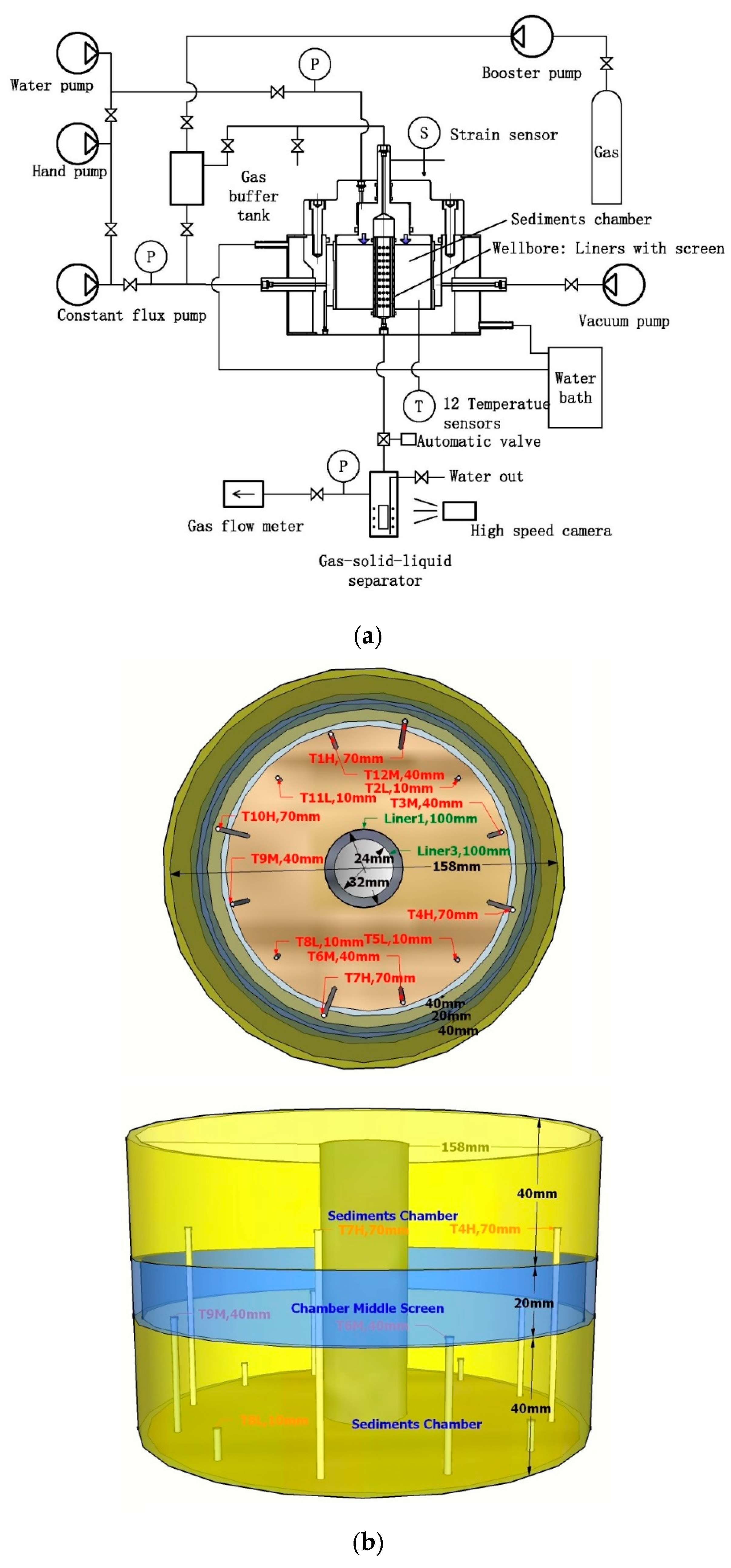
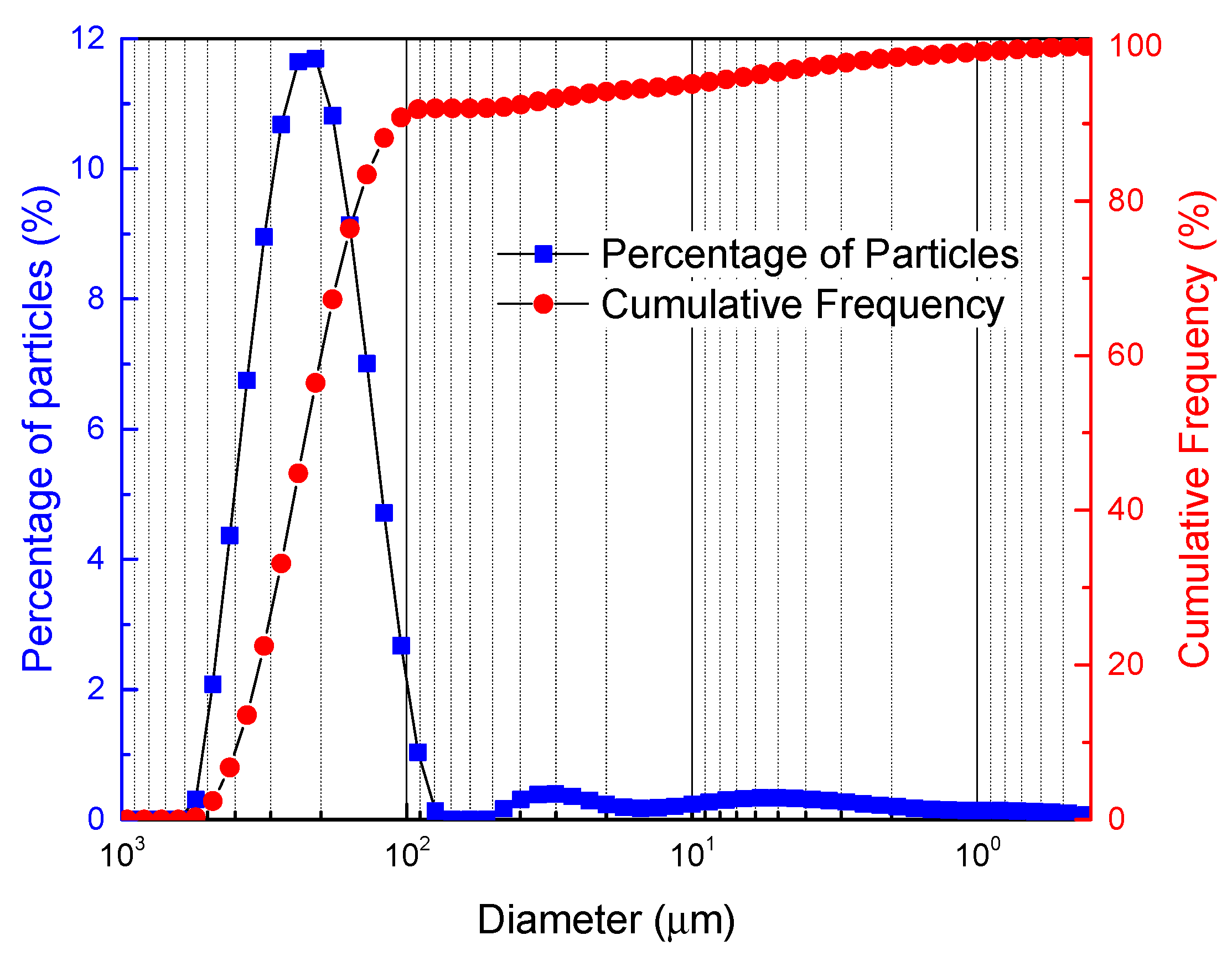
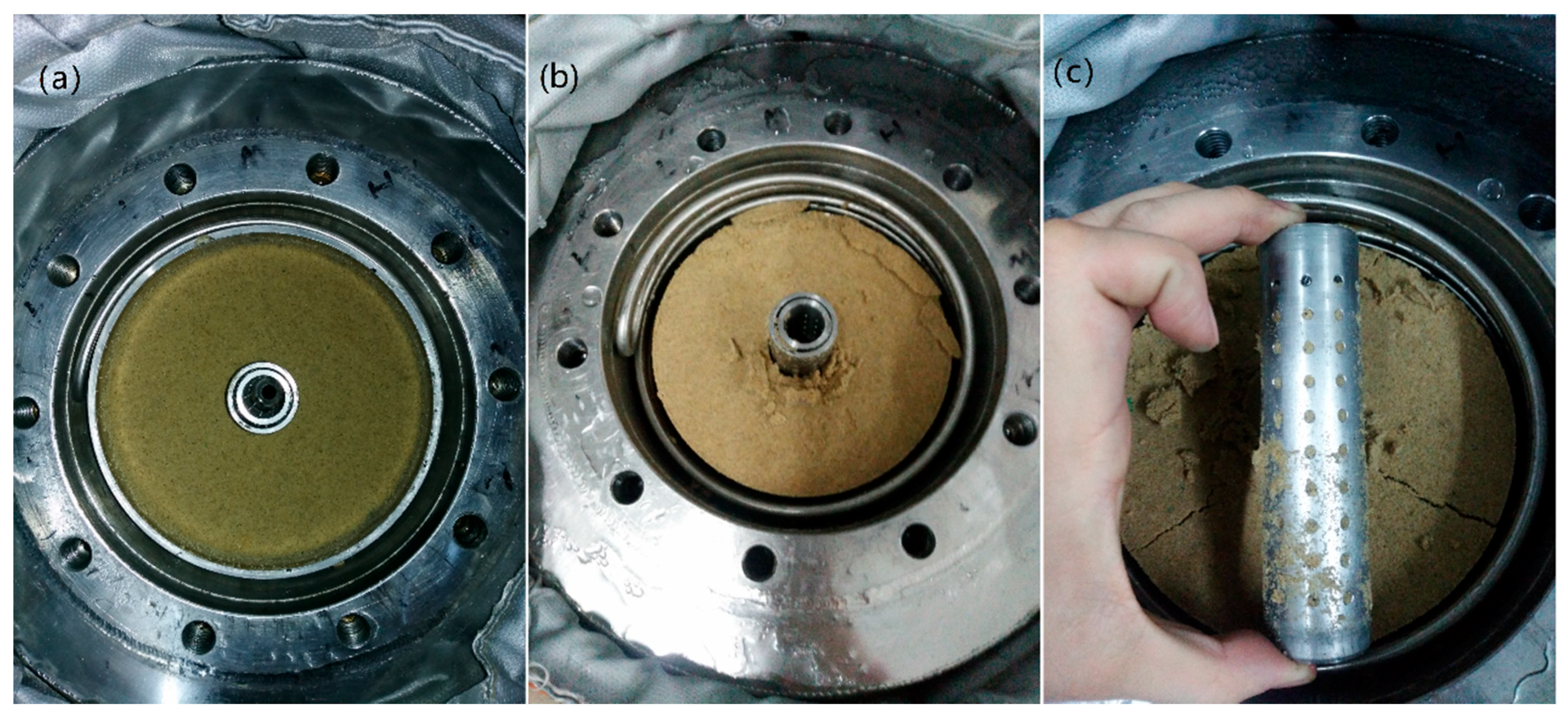

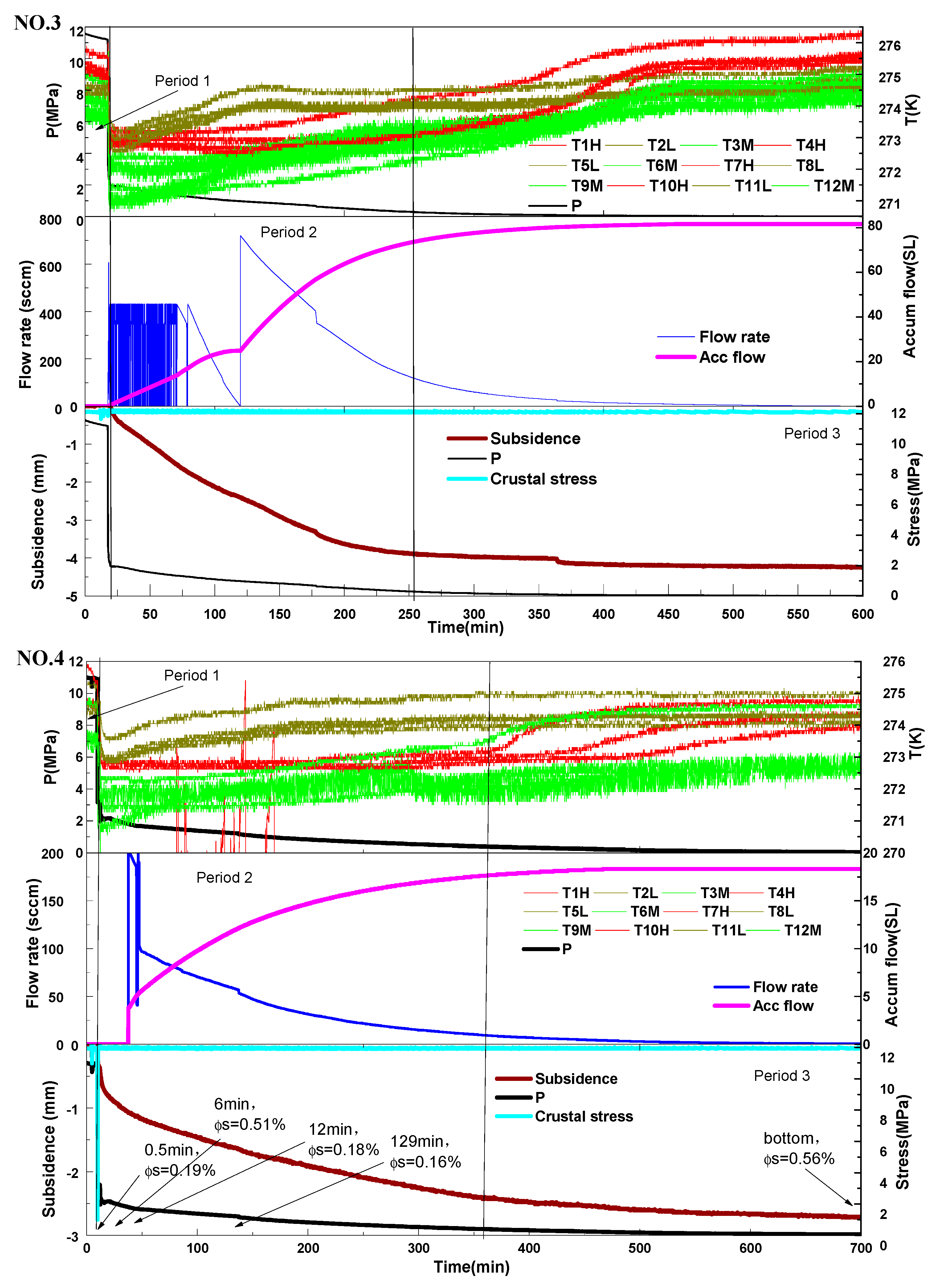

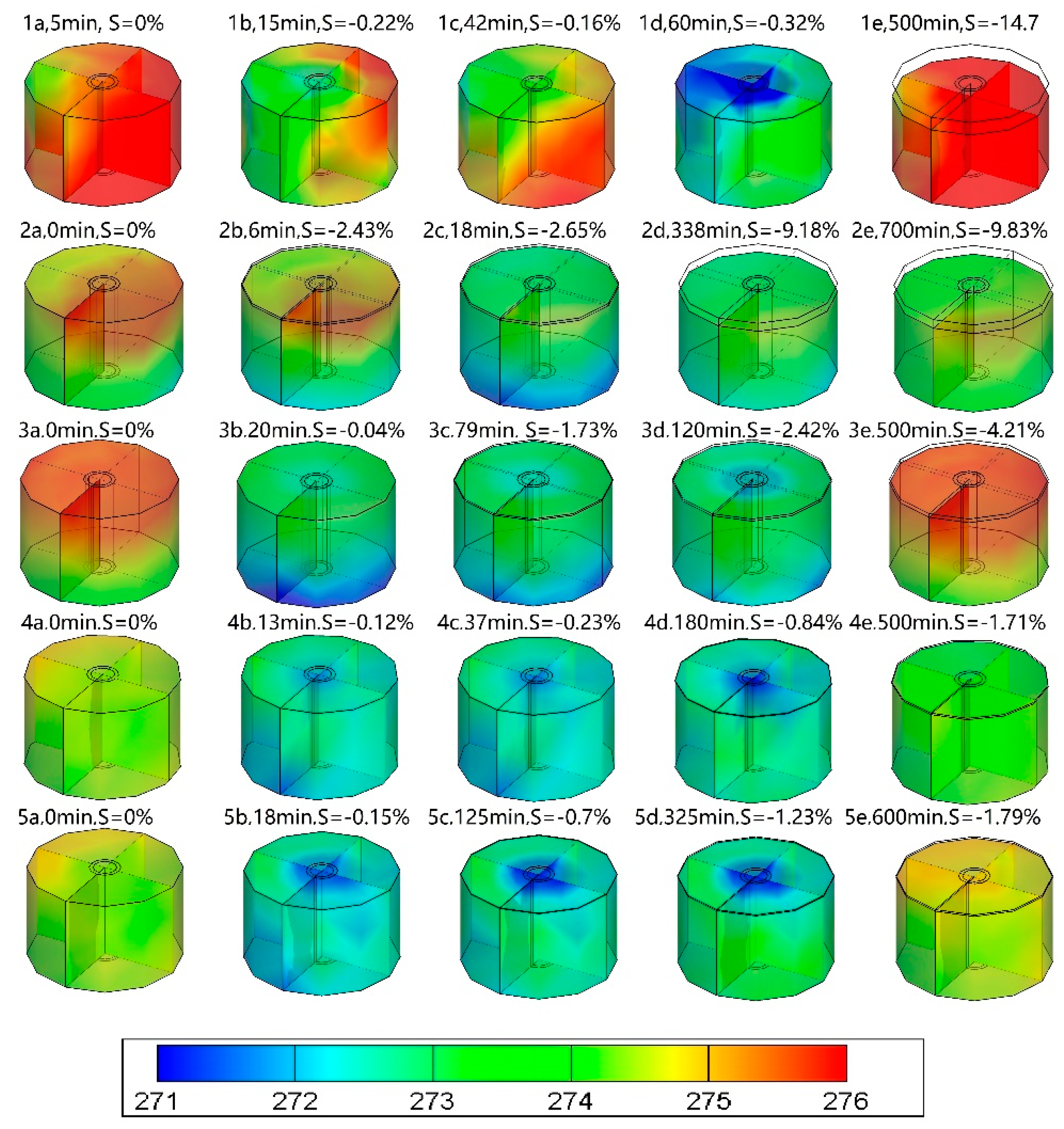
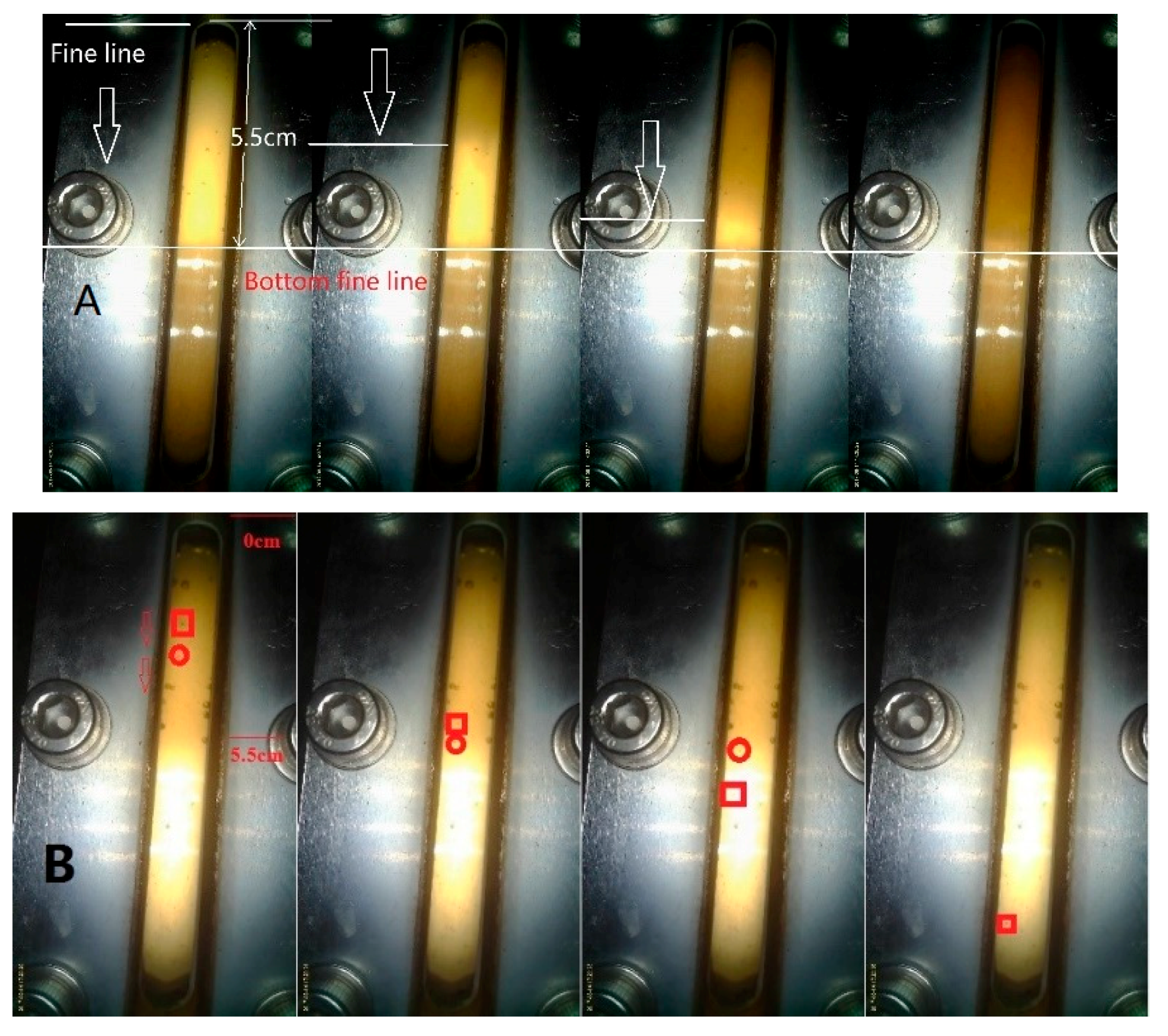
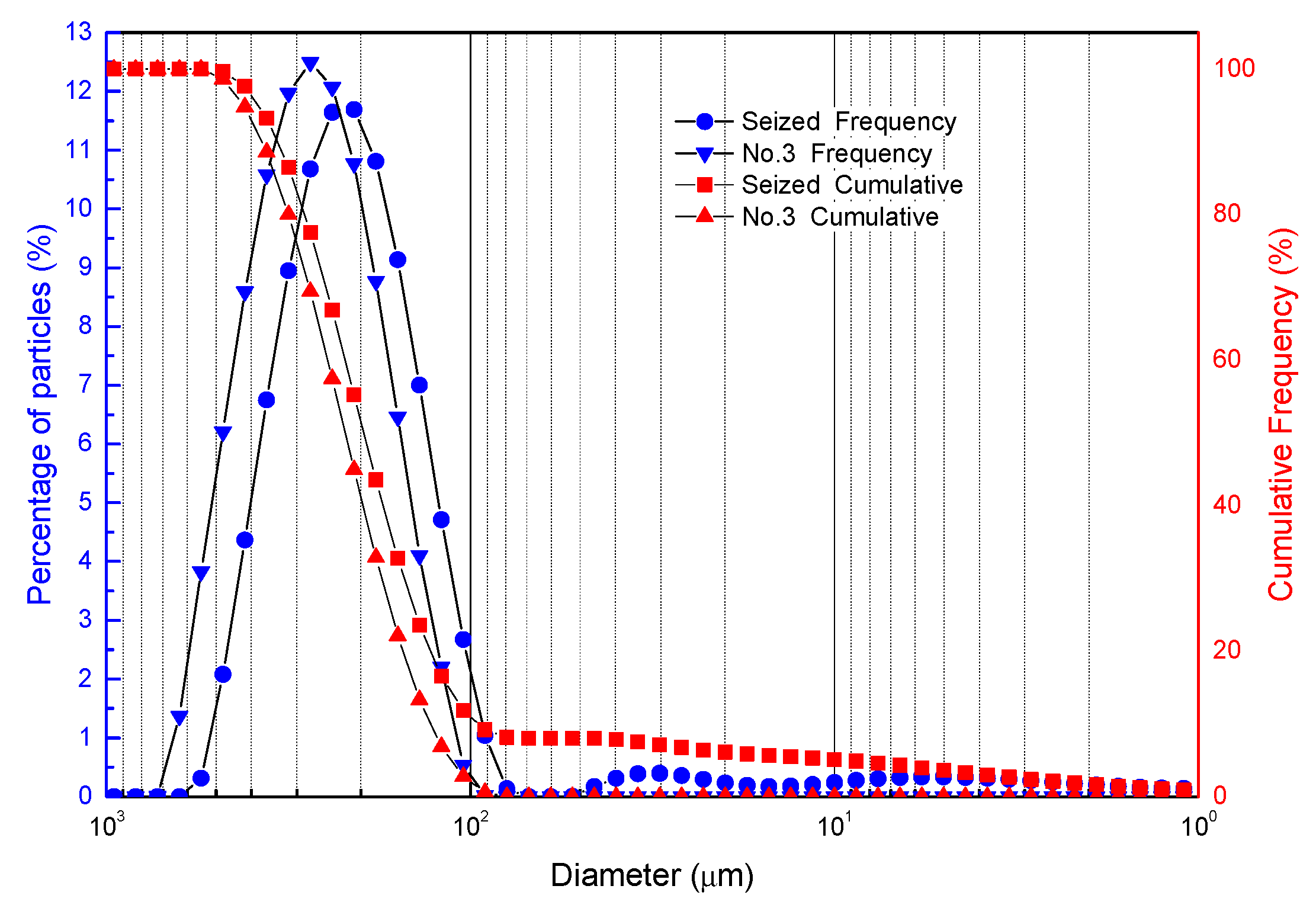
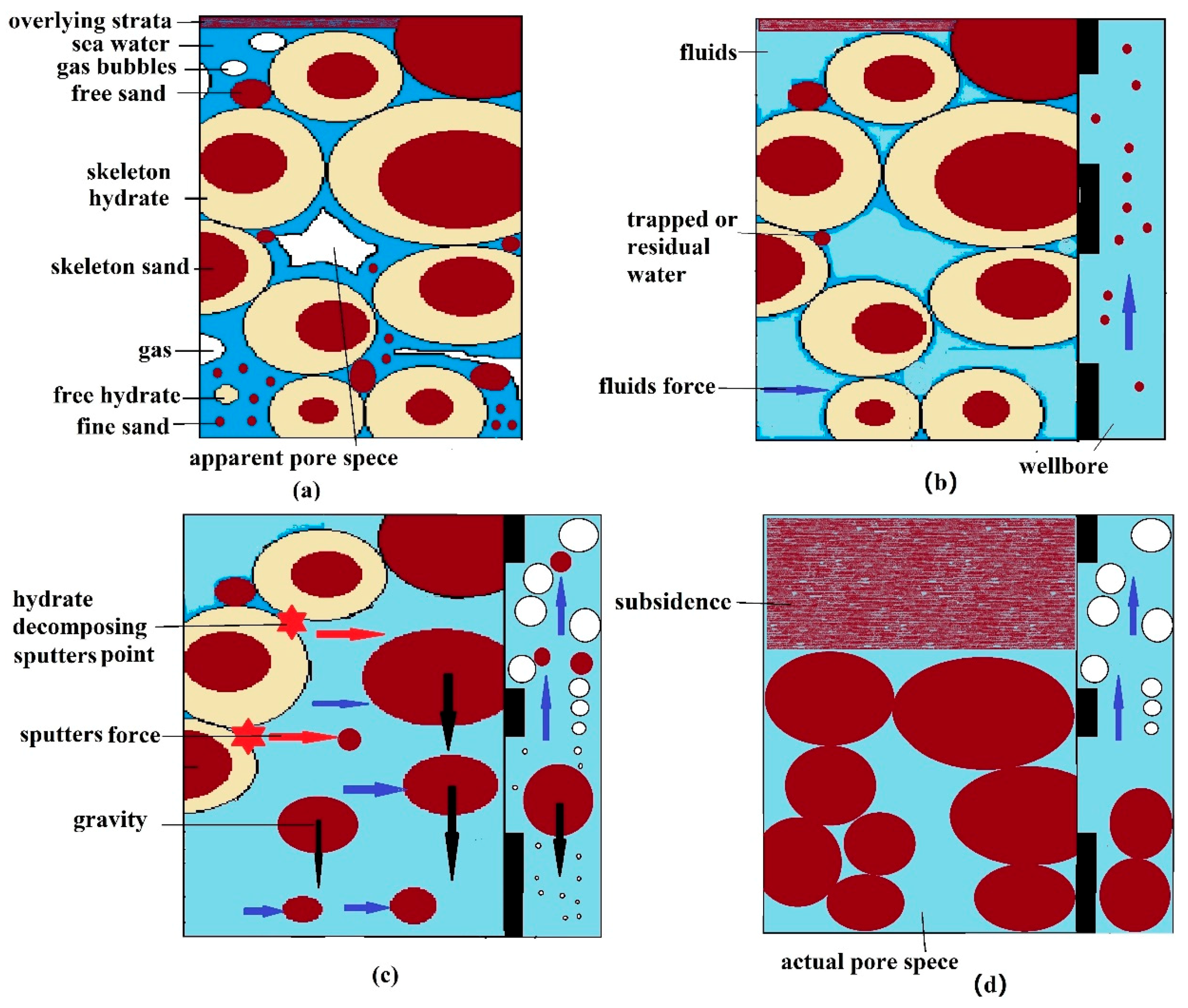
| Materials | Properties | Supplier |
|---|---|---|
| Sand | d (0.5) = 225.67 μm, uniformity 0.40, specific surface area 0.18 m2/g, density 1.63 g/mL, porosity 28.52%, | GMGS |
| Deionized water | Resistivity: 18.2 mΩ/cm | Laboratory |
| Methane | Purity: 99.99% (mole fraction) | Shiyuan Gas Co. |
| No. | Initial Water Rates (%) | Ideal Hydrate Saturation in Pore (%) | Gas Production (L) | Water Production with Sand (g) | Hydrate Saturation (%) | Sand Production (g) | Total sand Production Rate (%) | Final Subsidence (%) |
|---|---|---|---|---|---|---|---|---|
| 1 | 3.01 | 12 | 40.31 | 450.00 | 38.86 | 3.63 | 0.81 | −14.82 |
| 2 | 20.00 | 80 | 153.35 | 563.37 | 100.00 | 17.28 | 3.06 | −9.91 |
| 3 | 25.00 | 100 | 81.69 | 873.11 | 73.83 | 27.65 | 3.16 | −4.26 |
| 4 | 10.00 | 40 | 58.75 | 467.33 | 53.10 | 1.69 | 0.36 | −2.73 |
| 5 | 12.50 | 50 | 52.42 | 640.87 | 47.38 | 1.14 | 0.18 | −1.93 |
© 2018 by the authors. Licensee MDPI, Basel, Switzerland. This article is an open access article distributed under the terms and conditions of the Creative Commons Attribution (CC BY) license (http://creativecommons.org/licenses/by/4.0/).
Share and Cite
Lu, J.; Xiong, Y.; Li, D.; Shen, X.; Wu, Q.; Liang, D. Experimental Investigation of Characteristics of Sand Production in Wellbore during Hydrate Exploitation by the Depressurization Method. Energies 2018, 11, 1673. https://doi.org/10.3390/en11071673
Lu J, Xiong Y, Li D, Shen X, Wu Q, Liang D. Experimental Investigation of Characteristics of Sand Production in Wellbore during Hydrate Exploitation by the Depressurization Method. Energies. 2018; 11(7):1673. https://doi.org/10.3390/en11071673
Chicago/Turabian StyleLu, Jingsheng, Youming Xiong, Dongliang Li, Xiaodong Shen, Qi Wu, and Deqing Liang. 2018. "Experimental Investigation of Characteristics of Sand Production in Wellbore during Hydrate Exploitation by the Depressurization Method" Energies 11, no. 7: 1673. https://doi.org/10.3390/en11071673
APA StyleLu, J., Xiong, Y., Li, D., Shen, X., Wu, Q., & Liang, D. (2018). Experimental Investigation of Characteristics of Sand Production in Wellbore during Hydrate Exploitation by the Depressurization Method. Energies, 11(7), 1673. https://doi.org/10.3390/en11071673





